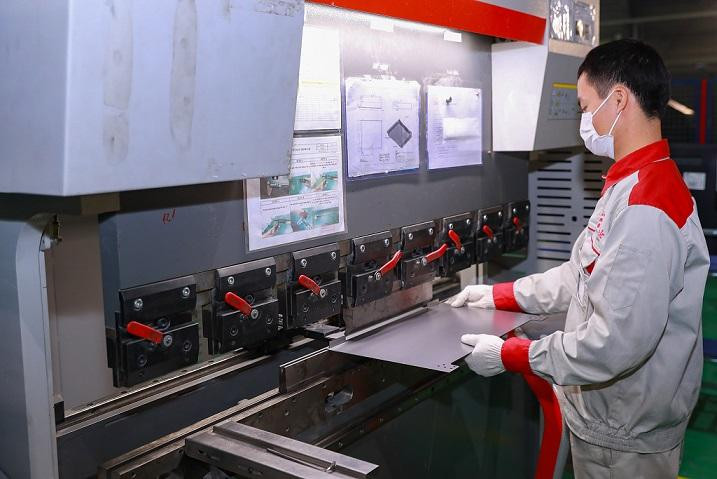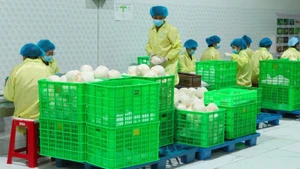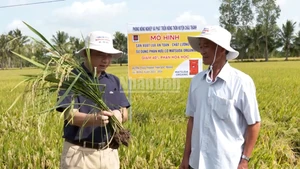According to the General Statistics Office, a surplus of 12.26 billion USD was reaped in the total state budget in the January-November period, with spending estimated to be more than 59 billion USD – a year-on-year rise of 3.4%.
Meanwhile, the state budget revenue is estimated to reach 71.26 billion USD, equivalent to 116.1% of the year’s initial estimates and increasing 17.4% year-on-year. All types of revenues have expanded year-on-year, mirroring almost all sectors in the economy bouncing back.
Concretely, domestic revenues hit 56.55 billion USD, equal to 110.5% of the year’s initial estimates, and climbing 13.5% year-on-year.
Revenues from crude oil sat at 3 billion USD, or 244.6% of the year’s initial estimates and rising 77.6% year-on-year.
It is also forecasted that revenues from exports of crude oil for the whole year will be 2.96 billion USD, a year-on-year expansion of 141.1% as compared to the initial estimates and occupying 4.2% of total budget revenues. This is made possible on the back of an increase in crude oil prices, averaged at 107.05 USD per barrel.
What is more, revenues from export-import activities in the January-November period touched 11.45 billion USD, tantamount to 132.4% of the year’s initial estimates and up 25.1% in comparison with that in the same period last year.
Total 11-month export-import turnover hit 673.82 billion USD – representing a rise of 11.8% year-on-year. In which the export turnover reached 342.21 billion USD – up 13.4%, and the import turnover stood at USD 331.61% – a year-on-year 10.1% climb. This would mean 10.6 billion USD in trade surplus.
It is predicted that the revenues from export-import activities for the entire 2022 will be as much as 18.26 billion USD, a 23.6% increase year-on-year as compared to the initial estimates – holding 15.2% of the total state budget revenues.
The central and local budget revenues for the whole year are estimated to exceed by 3.47 billion USD and 5.65 billion USD, respectively.
This year, the government does not precede a priority on collecting budget revenues, and instead it focuses on using the country’s resources to assist the business community whose production and business activities are in critical need for recovery. So far this year, the total value of support for enterprises and people has been nearly 8.09 billion USD. Such assistance has enabled businesses to bounce back with profits, which then create contributions to the state coffers.
In an example, state-owned Vietnam Oil and Gas Group (PetroVietnam) has already completed its plan this year on exploiting oil and gas. Its total revenue target for 2022 has also been hit by late August. By October, the revenue reached 34 billion USD, surpassing by 40% of the whole year’s plan and up 56% in comparison with the same period last year.
Petrovietnam’s general director Le Manh Hung said the group has also completed its plan for the whole year on contributions to the state coffers six months beforehand.
In the first 10 months of 2022, PetroVietnam contributed 4.89 billion USD to the state budget, surpassing by 74% of this year’s plan and equivalent to the realised figure of last year. This also means that this group has accounted for as much as 7.7% of the whole economy’s total budget revenues. PetroVietnam’s 10-month contributions to the state budget from crude oil stood at 2.84 billion USD, up 95% year-on-year and exceeding by 2.3 times as compared to this year’s initial estimates.
PetroVietnam’s good performance has also helped enrich the budget of the southern province of Ba Ria-Vung Tau, where many projects of the group are based. The province’s 10-month revenue from crude oil reached 1.67 billion USD, equivalent to 231.3% of the initial estimates and up 202.4% year-on-year.
In another case, Vietnam National Coal and Mineral Industries Group (Vinacomin) also reported that in the first 11 months of 2022, it churned out 36.5 million tonnes of coal, up 1% year-on-year; 1.34 million tonnes of alumina – of which 1.31 million tonnes have been consumed. Vinacomin’s revenue is estimated to touch nearly 6.4 billion USD, a year-on-year climb of 18.7%. The group contributed 930.43 million USD to the state budget.
Cao Anh Tuan, Deputy Minister of Finance, commented, “Thanks to positive budget revenues, we can ensure major balances for the economy, and can earmark more money for raising salaries and for investing into ensuring social welfare and national defence and security.”
The government has reported to the National Assembly (NA) that the total state budget revenue for this year is estimated to be 70.18 billion USD – exceeding by 8.8 billion USD or 14.3% as compared to the target set in November 2021 by the NA, also up 2.9% against the figure realised last year.
Revenues from all economic sectors are set to see a year-on-year increase. Specifically, domestic revenues are estimated to be USD 56.18 billion, up 9.8% year-on-year or 5.02 billion USD as compared to the initial estimates. This accounts for 80.1% of total budget revenues.
It is also estimated that the budget deficit in this year will be 4.5% of GDP, which will still stay within the NA’s permissible limits of a maximum level of 5-5.1% of GDP.
The government expected that the economy’s GDP will be about 403.2-405.3 billion USD this year – thus the total budget deficit for 2022 will be about 18.14-18.23 billion USD.
A few weeks ago, the NA adopted a resolution on allocation of central budget in 2023 – the key legal foundation for making plans on use and management of the state budget for national socioeconomic development next year.
Under the resolution, total central and local budget revenues will be 37.54 billion USD and 32.92 billion USD, respectively. Total central budget expenditure will be 56.26 billion USD. This would mean a central budget deficit of 18.72 billion USD.
“The government is ordered to promote the financial disciplines and rules, with all violators being strictly sanctioned, and punishments being imposed on those that delay and obstruct the speed of capital allocation and disbursement,” read the resolution. “The responsibility of heads of units will be individualised if their units face delayed disbursement and fail to fulfill assigned tasks.”
Source: World Bank
The monthly budget balance registered a 0.2 billion USD surplus in October after a brief fall into deficit in September. The surplus was achieved despite a 6.7% year-on-year decrease in total revenue, the first drop in 2022. Total expenditure increased by 11.8% year-on-year, mostly reflecting low-base effects. As of end October 2022, the government collected 3.7% more than the planned total revenue for the year, but spent 68.3% of planned total expenditure, resulting in a 10.7 billion USD budget surplus. Public investment disbursement reached 56.6% of the plan approved by the National Assembly, more than two percentage points higher than a year ago (53.9%) while 75.7% of planned current expenditures were spent, lower than to the 77% rate achieved a year earlier.
The economy faces strong headwinds. Slowing external demand and tightening global financial conditions are affecting the exchange rate. Rising inflation and tightening domestic financial conditions could affect domestic demand during the next months.
As the US Fed is expected to continue raising interest rates, Vietnamese monetary authorities could consider allowing further flexibility in the exchange rate, including through a quicker pace of depreciation of the reference rate. This could be complemented with continued use of reference interest rates, especially if faster depreciation leads to higher inflation and inflation expectations rise. Given the persistence of exchange rate pressures, direct FX sales should be used judiciously to preserve the FX reserves. Fiscal and monetary policy coordination will be critical to ensure price stability in light of accelerating domestic core inflation.
















